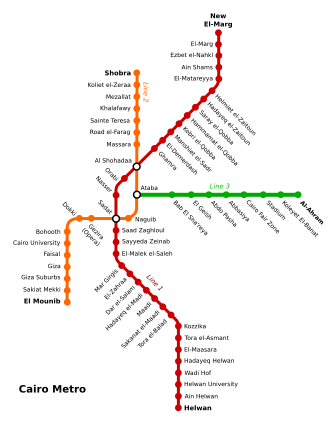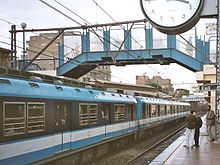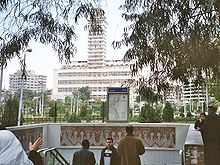Cairo Metro
The Cairo Metro ( Arabic مترو أنفاق القاهرة, DMG mitrū anfāq al-qāhira ) in Egypt's capital Cairo is the only fully developed subway system in Africa besides the Algiers metro . There are currently three routes in operation, with the third subway route only being opened on a small section. All lines run on the standard gauge of 1435 mm.
stretch
line 1
At the beginning of the 1970s, the traffic problems in the Egyptian capital Cairo became increasingly serious. Long traffic jams were not uncommon. Therefore, in 1973, an underground expansion plan was decided by the Egyptian government. This initially envisaged a system of three lines.
Line 1 (Red Line), opened in 1987, actually consists of three parts, two suburban railway lines and a long section of tunnel in the center of the city. Line 1 is used much more than the only other line to date and connects the industrial site of Helwan in the south and the populous suburbs around El Marg in the north. The suburban railway lines that were integrated into the subway line accounted for 81% of the suburban railway traffic in 1971. From a purely technical point of view, the route is part of the Egyptian railway network, as freight traffic also takes place here. No other passenger trains run here. The southern railway line to Helwan was opened as a state railway in 1877. In 1888 the line was privatized and operated by the Suares Brothers Society. A year later, the route was re-routed, now it ran parallel to the Nile in the southern part of downtown Cairo. There it even got its own terminus. At least since then, there have been projects to connect the north and south routes, as happened with the construction of the subway. A first application by the Suares company for the construction of such a connection was rejected in March 1890. In 1904 the company changed again, now Delta Railways , until it was nationalized in 1916. In 1956, the Egyptian State Railways electrified the route, which was a special feature of the steam-powered railway network at the time.
Line 1 was completed in three steps: in 1982 the first construction work began, on September 27, 1987 the underground tunnel section in the center of Cairo from Al Shohadaa (at that time Mubarak , exit to Ramses station , Cairo's main station) to Sayyida Zeinab was opened. This also included the conversion of the southern railway line to underground operation. 4.8 km of new line had to be built, 22.5 km belonged to the existing line. On April 12, 1989, the northern railway line could finally be converted. This extended from the Al Shohadaa station to El Marg . The new route to be opened was 15.4 km long. Another station was added in May 1999. Single-track operation from El Marg to New El Marg began. This route is a total of 1.3 km. Nevertheless, many trains still end at the previous terminus, El Marg. In total, line 1 is around 44 kilometers long and has 35 stations. Almost all stations have side platforms that are up to 197 meters long. The maximum capacity of the line is two million passengers per day, currently around 1.4 million passengers use line 1 per day. The top speed on the route is 100 km / h, and at peak times it is driven every 210 seconds. Technically possible, however, would even be a 150-second cycle. The trains are manned at both ends to ensure fast clearance. Line 1, which is more like an S-Bahn due to its relatively high distance between stations and line speeds, is colloquially known as the “French Line” . This is because the vehicles on this route were designed by the French rail manufacturer Alstom .
Line 2
According to the expansion plan of 1973, line 2 should run from El Mazallat in the north to Cairo University in the south . The route length should be 13.5 km. After some negotiations, the plans were expanded in the north by 2.5 km to Shubra el Kaima and 3 km to Um el Mesrien (also Giza Suburbs ). The line was created completely new, that is, not like the first line on existing routes. The first construction work began on June 12, 1993. The line reached its present state in five stages:
- October 1, 1996: Shubra el Kheima - Al Shohadaa ( Ramses train station ) , 8 km
- September 1997: Al Shohadaa ( Ramses train station ) - Sadat , 3 km
- April 19, 1999: Sadat - Cairo University , 5.5 km
- October 8, 2000: Cairo University - Giza Suburbs , 1.7 miles
- January 17th, 2005: Giza Suburbs - El Monieb , 1.6 miles
Today line 2 is about 22 km long and has 20 stations. The subway runs underground on the El Behous - Al Shohadaa section . The first Nile undercrossing in all of Africa took place here , for which the slot construction method was used, as the soil here consists largely of rubble and heterogeneous deposits from the river. In order to avoid water ingress, the outer walls of the tunnel were built with 1 to 2 meter thick special concrete. The bottom of the tunnel is about 30 meters below the site. In the northern part, the subway runs over a viaduct and ends at the Shubra el Kheima station at ground level , where the depot for line 2 is also located. In the south, Line 2 runs parallel to the Nile Valley Railway , which leads to Upper Egypt . There were also two transfer stations to the long-distance railway. As with Line 1, there are almost only side platforms on Line 2, which are 144 meters long. The maximum route capacity is 1.85 million passengers per day at top speeds of up to 80 km / h and a 105-second cycle. Around 1.2 million passengers are transported every day, the minimum cycle time is three minutes. The construction costs for the entire line, which is also called "Japan Line" (Japanese line) because of the trains originating from Japan , amounted to around 2 billion US dollars .
Line 3
After several announcements, according to press reports, the first section of line 3 was opened on February 21, 2012. It includes the stations Attaba (transition to line 2), Bab el-Shaaria, El Gheish, Abdou Pasha and Abbasiya and is to be continued to Cairo International Airport. According to the decision of the Egyptian Cabinet on February 22, 2012, the new line will be called the "Revolution line". The previous construction costs amounted to approx. 4.2 billion EGP or the equivalent of approx. 580 million euros . After completion of the second construction phase from Abbasiya to Ahram Square in Heliopolis, an average of 600,000 passengers per day, after completion of all three construction phases (approx. 2016/2017) on all sections of Line 3, up to 2 million passengers are expected daily.
The entire route of line 3 should be 34.2 km long and have 29 stations. In contrast to the other two routes, this line should run completely underground. The construction of the line is planned in 4 stages:
- Stage 1: Attaba - Abbassia, 4.3 km and 5 stations (opened in early 2012)
- Stage 2: Abbasia - Al Ahram, 6.2 km and 4 stations (opened May 7, 2014)
- Level 3: Attaba - Imbaba / Mohandessin, 11.6 km and 12 stations (duration 3 years)
- Stage 4: Al Ahram - Cairo International Airport, 12.1 km and 8 stations (duration 4 years)
The most technically demanding task is to cross under the Nile (between the stations Boulaq on the east bank and Kit Kat 'on the west bank; with the intermediate stop at Zamalek on the Nile island of Gezira) in stage 3.
A total construction time of ten to twelve years is planned, which can be achieved by overlapping the construction stages. Passenger forecasts assume around 1.8 million passengers a day when the route is completed. In terms of technology, line 3 should be very similar to line 2, as it should also be operated by busbar . Estimates of the cost of construction stages 1 and 2 assume around 4430 million Egyptian pounds (around 575.9 million euros). The European and Japanese development banks have promised financial cooperation. Two consortia under the leadership of the rail vehicle construction group Alstom are supplying signal technology, communication and electromechanical equipment for the first 4.3 km section between Attaba and Abbassia.
technology
Line 1 clearly shows its relationship to the railroad with power supply via pantographs and overhead lines. On this line, three-part trains in the form of a railcar-sidecar railcar, which were supplied by the French railway manufacturer Alstom , are used. A total of 100 units were delivered to the Egyptian state railway company in 1983 and 1984, i.e. before the subway opened . However, she had no experience with maintenance, which is why the trains were initially serviced by Alstom. In 1993, 1994 and 1999, Semaf supplied another 39 identical three-unit units. All trains on Line 1 have transverse seating, i.e. 2 + 2 facing each other. There are both units that are equipped with air conditioning and those with fans . There are currently 139 train units.
From a technical point of view, there are clear differences between lines 1 and 2. On line 2, power is drawn and returned by power rail , which is more like a typical subway . The trains were developed and produced by Kinki Sharyo and the companies Toshiba , Mitsubishi and Semaf. First 6-car units were delivered, which consist of two end cars and four middle cars. After the opening of the first four construction stages, these were expanded by two intermediate cars each so that the full length of the platform could be used. Annual vehicle deliveries took place in the years 1995–2000. Today there are a total of 35 units. In March 2004, the Egyptian Ministry of Information announced that seven more trains would be ordered for the equivalent of 73.12 million euros. Another difference to Line 1 is that there are no transverse seating, but lengthways seats. All units are air-conditioned.
business
Even if the Cairo metro was created out of the railroad , there is, as almost everywhere with the subway systems in the world, only one class of car. In the past, the first car of a train was designated as a special women's compartment on all routes in Cairo , but now there are two carriages with red markings (only for women) and two with green markings in the middle section of the train set. These can only be used by women during the day, but the fifth car from 8:00 p.m. can also be used by men. In addition, blue signs with pictograms on the platforms indicate the exact stopping point of these cars. There are arrows on the platform so that waiting passengers can immediately see where to line up, as the trains stop at the platform in such a way that the doors of the train stop exactly at these arrows and there is no unnecessary crowd. However, this entry and exit system has not proven itself in practice.
In contrast to the other means of transport in the Cairo area, the metro differs primarily in terms of cleanliness, safety and order. Every station - which is signposted in both Arabic and English - is manned, a subway patrol ensures that no graffiti or other things are carried out there. They also monitor and enforce the ban on photography that applies everywhere. The ticket system is very similar to the Paris Métro ; The passenger buys a card with a magnetic strip and has to swipe it through the lock at each exit; the card is valid for a journey with transfer authorization. The cards can be bought at ticket offices, there are no machines. A single trip currently costs two Egyptian pounds . The operating times for both lines are daily from 5:00 a.m. to 12:00 a.m.
Despite the long distance between stations, the load on the two subway lines is relatively high; they can be compared with the Latin American subway system in Rio de Janeiro , Santiago de Chile and Mexico City . About 20 percent of all motorized journeys in the Cairo metropolitan area fall on the subway system. In 2004 a total of 949 million passengers were carried.
Further expansion
As already mentioned, the original expansion plan from 1973 provided for only three lines. The third line was to run from eastern Darassa under the Nile and the city center through to western Imbaba . The existing lines should be crossed at the Attaba (line 2) and Nasser (line 1) stations.
As the situation changed in the following years due to other priorities and changes in the Cairo area, the “ Greater Cairo Public Transport Study ” was developed in 1998 and presented in 2000. The construction plans with the horizon 2022 provide for four more lines in addition to the existing lines. Even if the route of line 3 remained essentially unchanged, there were minor changes. In the east, the subway line 3 is now to connect the Cairo airport , in the west a 3.6 km long branch branches off the main route to Mohandessin .
In addition to line 3, three other lines are planned in the study:
- Line 4: Nasr City - Abbassia - Giza - El Haram (about 24 km)
- Line 5: Nasr City - Heliopolis - Shubra el Keima (about 19 km)
- Line 6: Maadi - old city center - Shubra el Kheima (approx. 21 km)
With the construction of these lines, the tram network in Heliopolis , which has already shrunk a lot but is still very efficient , will face major competition. Although letters of intent for the reconstruction of the tram have been made, they must be called into question on the planned routes.
literature
- WJ Hinkel, K.reiber, G. Valenta and H. Liebsch: yesterday-today-tomorrow - subways from 1863 to 2010 . Schmid-Verlag, Vienna 2004, ISBN 3-900607-44-3 (chapter "Cairo")
- Dipl.-Ing. Christoph Groneck: Article Metro and other public transport in Cairo: development and perspectives . In: Stadtverkehr Heft 2/05, EK-Verlag, Freiburg
Web links
- Official Cairo Metro Website (Arabic)
- Official website of the Cairo Metro (English)
- The National Authority for Tunnels (NAT) - Office for Tunnels (Arabic, English)
- The Cairo Metro at Urbanrail.net (English)
Individual evidence
- ↑ The first phase of Cairo's third line to be opened Tuesday, says source ( Memento from January 22, 2016 in the Internet Archive ) al-Masry al-Youm, online edition from January 5, 2012
- ↑ Cairo's third underground line opens Tuesday, connects Ataba and Abbasiya Al-Ahram Online (English) of February 21, 2012
- ↑ Cabinet names metro's new third line 'Revolution line' al-Masry al-Youm, online edition (English) from February 22, 2012
- ↑ Cairo metro Line 3 extension opens. In: Railway Gazette. May 8, 2014, accessed May 8, 2014 .
- ↑ Blickpunkt Tram , Edition 2/2007, page 96






